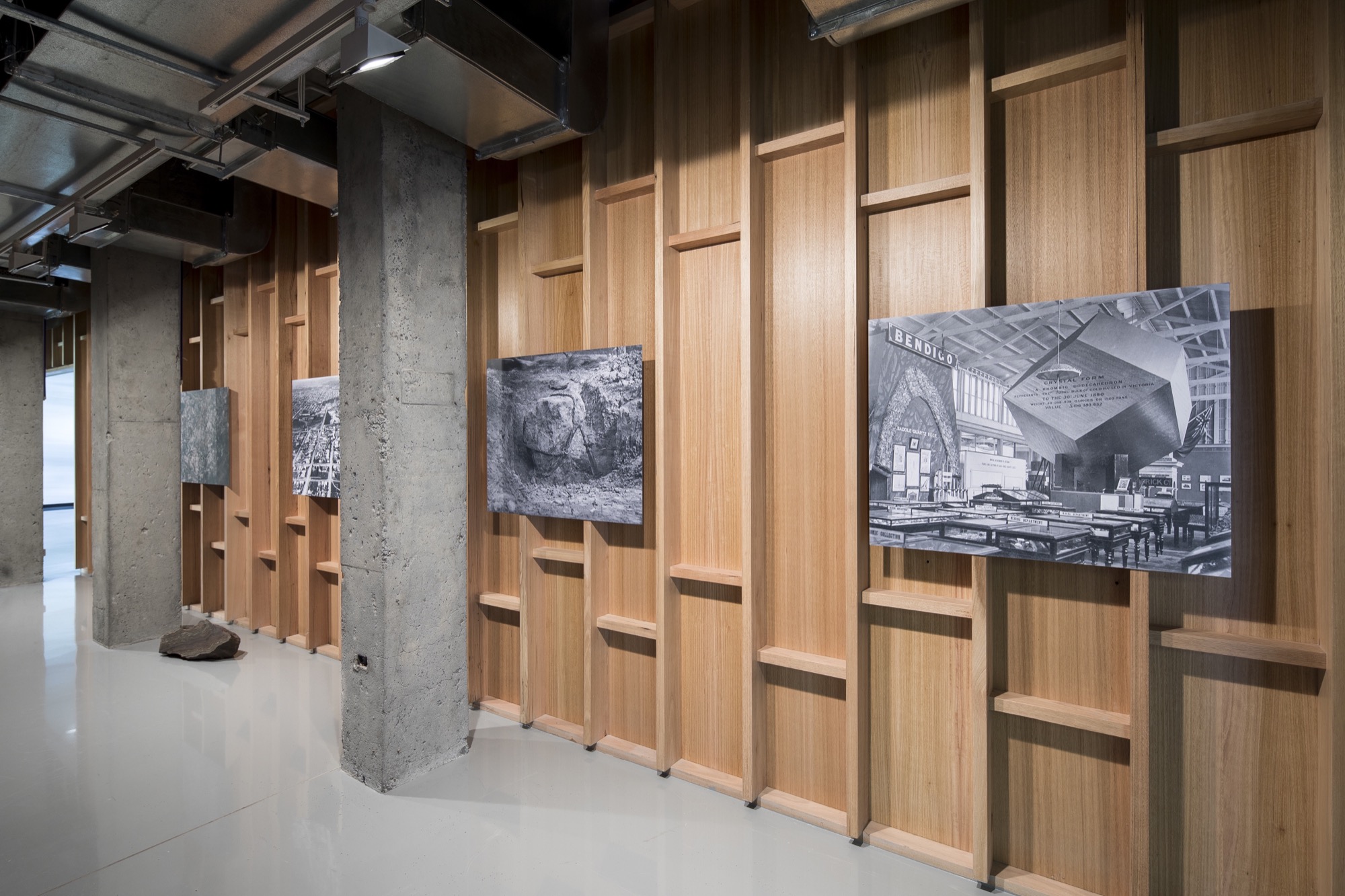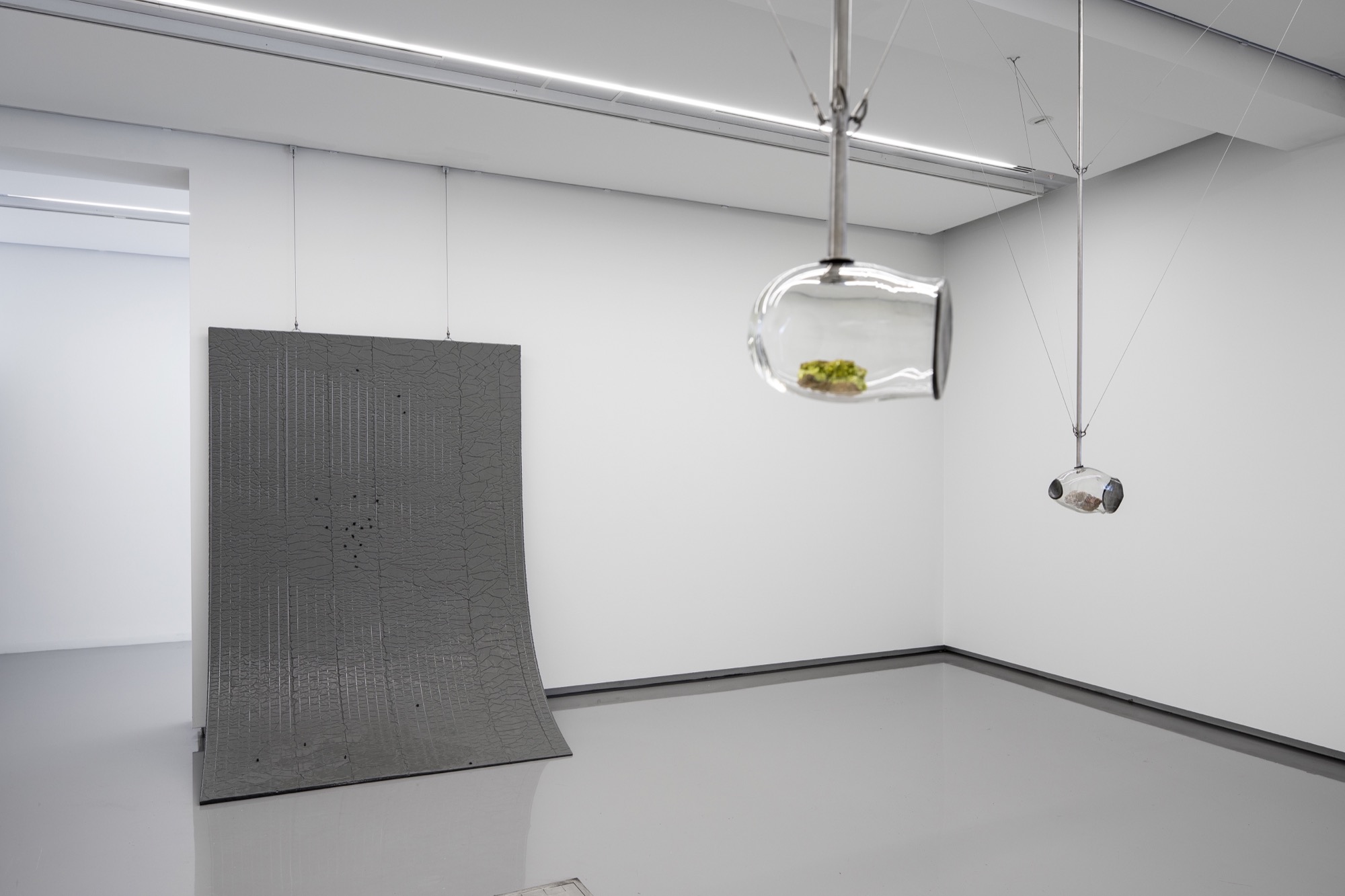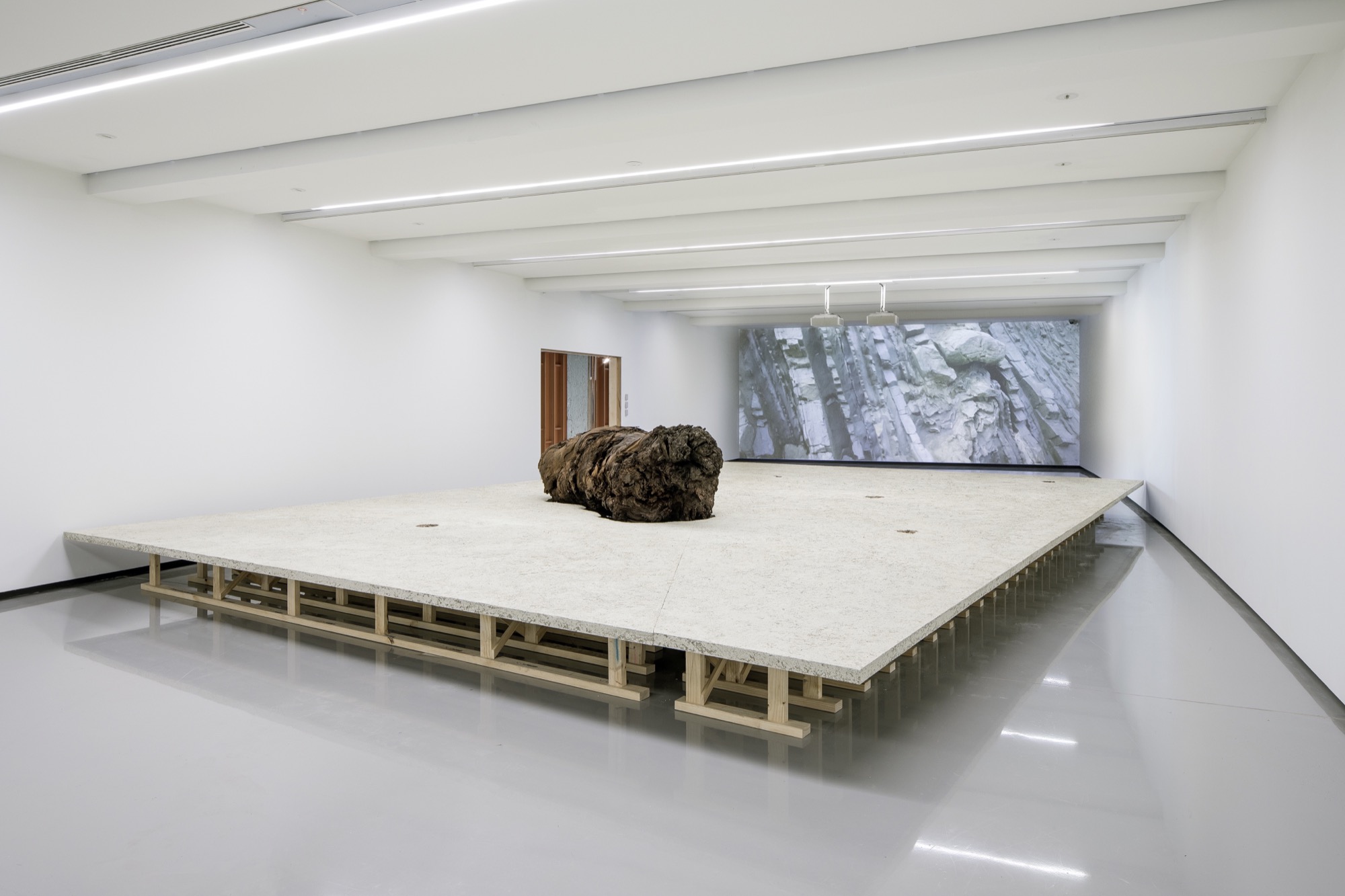Open Spatial Workshop: Converging in Time
Giles Fielke
Somewhere between geology, geography, colonisation and resource extraction is where Open Spatial Workshop (OSW) attempt to situate their highly conceptual, sculpture-based exhibition entitled Converging In Time. A huge, fossilised Kauri tree log found within a coal seam in the La Trobe Valley lies on a large, rectangular papercrete platform that has been constructed adjacent to the slightly curving gallery wall of the North Gallery of Monash University Museum of Art. The knee-high edifice means visitors cannot pass by it, they must enter and exit the space through the same door. Any possibility of aesthetic satisfaction has been foreclosed by the troubling nature of the objects meticulously arranged in this space.
For their first major museum exhibition, the enormity of the frameworks harnessed by OSW initially threatens to engulf any coherent sense of the work. Only slowly does the topic of mineralogy and sand as a metaphor of time begin to appear as the structuring principle of the carefully selected and embellished objects exhibited as sculpture. The addition of the intellect to objects, as Roland Barthes remarked of this kind of structuralist activity, means certain functions can be made to appear. As he once wrote, 'Structural man takes the real, decomposes it, then recomposes it'. But what seems to correspond to the continuing enthusiasm of research institutions for embracing functional interdisciplinarity is that if art is best put to work, it must demonstrate something about science. In the context of contemporary art, this idea is apposite to the relational, performance-oriented, and objective presentness of the works in the show, ambiguously harnessed here to construct a sense of meaningful display. Namely, OSW's practice focuses on a network of object-sculptures. It suggests both the objects and their accompanying documentation are intended to didactically acculturate the viewer by proposing a temporal model that approaches the notion of 'deep time', a concept borrowed from science, lending a mathematically sublime edge to the presentation.

In the background of the various geological objects placed around the galleries, often in strangely designed, lead-capped glass vitrines hanging from the ceiling, seamless videos scan the sites of excavation and experimentation from similarly ceiling-mounted projectors. Responding to the emerging notion of a measurable epochal shift, now called the Anthropocene, artists Terri Bird, Bianca Hester and Scott Mitchell, who all have individual artistic practices (as well as all working as institutional lecturers), direct OSW as a collaborative project in order to stage situations whereby the viewer could come to figure how the domestic environment is shaped by the past. Previously this has included installing an air-conditioning unit on a hot day in Melbourne's inner-west, proposals for a public sculpture in Melbourne's Docklands, as well as the ambitious inauguration of the West Brunswick Sculpture Triennial in 2009. Here their direction expands to engage others, technicians and scientists, as well as other artists, like the glass blower Sary Zananiri and photographer Polly Stanton, effectively creating a museum drawn from the museum. Many specimens, like the log fossil, are on loan from the Museums Victoria collection, which OSW has effectively mined. It is not certain that they are here to be understood as artworks, however.
At one stop along the way through the six galleries and connecting spaces utilised for Converging In Time, a humble and broken boulder appears, lying discreetly on the museum floor. With no wall texts, the room sheet reveals this to be a 2015 work by OSW entitled Anthropocite. A relatively small part of the show at the Caulfield campus gallery that has been open now for more than a month, it is a key for understanding the exhibition as a whole. On loan from its permanent home in the Monash Earth Sciences Garden, for which it was commissioned to become a part of the Monash University Collection, the natural-looking object, a rock, is revealed to have been manufactured by the artists using a combination of various pulverised materials. The artist-made slurry, baked to produce a new piece of earth, appears uncanny when placed alongside fossils and crystallised metals – like the piece of banded iron from the Pilbara in W.A. that has been placed on the floor nearby.

If the structuralist activity, recomposing the world, places OSW within the lineage of modern sculpture, it is perhaps one posed in opposition to Carl Andre's Zen-like statement that 'a thing is a hole in a thing it is not'. Recycled materials were used to create the anthropocite rock: concrete, glass, plastic. A redundant display screen, the computer monitor's degradation hastened, features invisibly as a part of the rock. This fabrication encases a Bluetooth beacon that leads you to a seven-minute video online, featuring a disembodied voice-over describing the effects of sedimentation in a painfully slow locution that mirrors the dust particles depicted majestically floating in and out of focus against the black ground of your computer screen. The credit sequence at the end of the video lasts for more than a minute. If it is an idea of nature that lingers at the basis of this geological quest, all of this technical mastery gives the exhibition a sense of the funereal. When Dr Alan Finkel AO, now Australia's chief scientist, opened the exhibition Technologism at MUMA in 2015, the museum's director Charlotte Day – she tells me while explaining further the works in the OSW show – was struck by his sensitivity to the importance of the media and also by his apparent lack of interest in the artwork itself.
One proposal for dating the arrival of the anthropocene is the animal husbandry evidenced by the sharp rise in chicken bones sedimented in our layers of garbage. If the epoch can be linked to aesthetic modernism, this nexus of art and science produces a curious emergence from the geological crisis of identity. Appearing in this deliberate dissolution of environmental matter it is only able to see art as only a vestige of industrialisation, however. Steel models of crystals fired into slumped plasticine, appear as a formalist abstraction in South Gallery 1, gesturing to OSWs earlier work Big Log Jam (2011). In this random mixture of elements, the objects chosen by the artists for their ability to produce naturally abundant geological forms even as seemingly banal as a large rock symbolises their intent to technologically transcend the usual dialectical models for form and content. In much the same way the organic / inorganic distinction is collapsed by the anthropocene in the sense that everything is now man-made.

In contrast to the relatively miniature mineral specimens assembled for the show, the exhibition's centrepiece in the installation of the fossilised Kauri log, which was found and collected from the Loy Yang open cut mine (Gunaikurnai) in 2006, proposes an ethical dimension to the otherwise formal posturing of the object-sculptures. The impressive monumentality of this 23 million year old tree stump lies in silent repose as an icon of the 20th century's emphasis on exploiting natural resources for energy, the industrial focus of the region. Of course now, with the media attention caused by the announcement of the Hazelwood coal-mine's imminent shut down, Converging In Time takes on an extra sense of urgency that adds to the palpable sense of displacement and exploitation already pervasive in the show. The log is surrounded by cast pockmarks the artists produced by dropping the Henbury iron meteorite into soil from a certain height. The documentation of this work on video is to be found behind the North Gallery, in the video room, a five-minute work titled Glimpse (2015). In many ways this revelation of process only adds the feeling of a frustratingly formal exercise when considered alongside the subtle narrative linking resource-mining to colonisation, arching back into a pseudo-experimental mode of object making.
As well as a day of lectures and events scheduled to tour sites in Victoria significant to the project, OSW have produced a nearly 400-page long catalogue to accompany Converging In Time. In the ambitious attempt to create a lasting document for an exhibition that is only on show for a limited period of time, the well-designed book featuring essays by Saskia Beudel, Matt Poll, and Kathryn Yusoff, aims at elaborating a long-term project in perhaps the same way that French art historian Georges Didi-Huberman's publication for Atlas. How To Carry the World on One's Back did for his project on the legacy of Aby Warburg in 2010/11. The exhaustion at feeling there is an endless amount of material to go on from the sparse set of objects collected in the gallery lends the show a further sense of dissolution, however. If the open aesthetics of interminable work is the goal of the project itself, Converging In Time leaves the viewer with a severe sense that the onus is now on them to properly engage with the brevity of what has been placed before them. If the initial focus of the show suggested object and intellect, this aspect is now lost in the miasma of referentiality. Is it in fact about power, both imperial and electrical? Or is it about time? Could it be about all of the above?

While contemporary artists' interest in deep time seems initially to engage with the sublime possibilities of abstract thinking, witnessed for example in Pierre Huyghe's recent video work De-extinction (2014), or Nicholas Mangan's Nauru project from 2010, it is another aspect of the work which links Converging In Time to a much more troubling feature of late-modernity now afflicting contemporary art: quantification as the only measurement of function. Soon after the anti-climax of the Y2K panic, the Berlin-based, North American artist collective Aids-3D emerged and semi-seriously proposed that museums consider hollowing out classical sculptures in order to allow them to house server farms from within the purely surface significance of their forms. Making the useless beauty of the solid material functional to industry was only one of the somewhat actively cynical gestures by the American duo who now pursue their work independently of each other (Nick Kosmas has since left the art world and Daniel Keller is represented by Krauper-Tuskany Zeidler). Importantly, there are no longer any people to populate the world imagined by OSW for Converging In Time. People just get in the way. The artists have themselves become omnipresent, both everywhere and nowhere in the objects they have chosen to place or make for the museum. A world devoid of bodies, dematerialised in preference for sedimented matter, posits both the post-humanist fiction of this 'dematerialised' culture, as much as it laments the very existence of an entire genus. Undoubtedly the presence of humans has accelerated changes to the climate and the environment. However, the obviousness of this point seems to address itself to the administrative side-show that is the up-to-the-second media cycle. When you take away the structural supports, the texts and theoretical wadding that wrap a highly conceptualised show such as this, what are we, the viewer, left with? Rocks, fossilised objects, a few images, that other than piquing our curiosity don't reveal very much to us.
Artist collaborators Ackroyd and Harvey, who have developed a specialised conceptual practice directed to addressing environmental concerns, are currently in Melbourne this weekend for a lecture tour. Their Welsh slate works, commissioned by the University of Cambridge for the façade of the David Attenborough Building last year, employ material that is more than 500 million years old. In a careful nod to the contemporary requirement to address sustainability, the slate used for their artwork is waste drawn from its use by the roof tiling industry. Representation is folded into utility. The lava bomb that OSW include as part of the structure in MUMA's South Gallery could be a material metaphor of the information bomb. Overcoded and disorienting, Converging In Time intends to knock viewers off their everyday temporal axis with its complex arrays of material metaphors desperately seeking representation. All things considered, it may motivate you, the viewer, to wonder how old the shit in your own backyard might be, and what it might be better used for, or worse whether it is useful at all.
Giles Fielke, March 2017
Title image: Open Spatial Workshop: Converging in time, installation view: Monash University Museum of Art, Melbourne, 2017. Photo: Andrew Curtis


